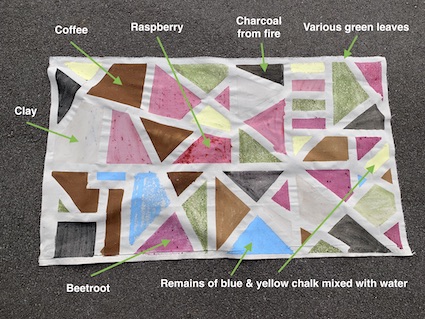
This week I’ve been presenting at the Aberdeenshire Council’s Early Years Conference. The theme has been Outdoor Literacy and my workshop focused on the natural art of mark making outside. However the process is easy enough for older primary children to understand as an art activity.
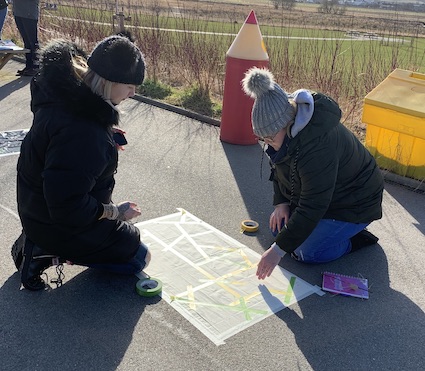
I wanted a series of practical explorations for the participants. They had spent 45 minutes listening to me give the keynote, so getting active, messy and thinking about ways in which art can motivate and engage children to mark make and build up their fine motors skills were the principle aims.
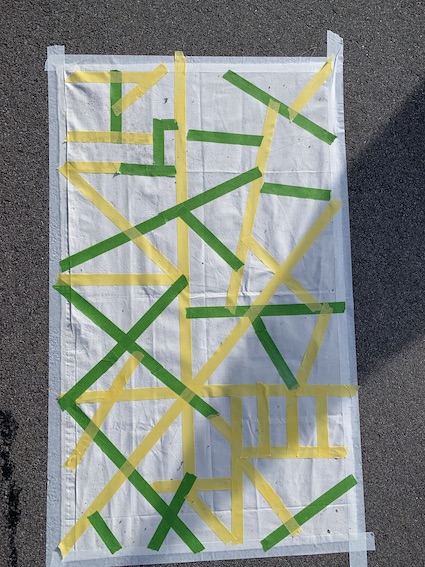
Today, I decided that it would be interesting for everyone to be involved in a group project that resulted in a wee thank you gift to the Early Years team that organised the conference. Group activities can work well with young children if there has been an interest expressed that makes this a natural next step. For example, the children may have been playing with masking tape or been fascinated that some of their snack such as beetroot produces stains their fingers.
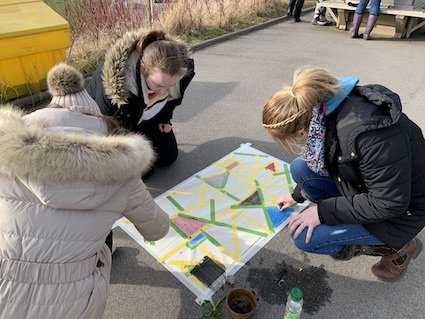
We began by taping the cotton sheet to the asphalt. Part of an old white, cream or light-coloured sheet works well. In order to make the lines stand out, we used yellow and green masking tape. This will bring about conversations about networks, pathways and the shapes created. From a pre-handwriting perspective, learning how to use masking tape, tear the paper, stick it down are all good skills to develop. I think there would also be play value in leaving the sheet in this state and seeing what happens when cars, dinosaurs or other small world toys are put nearby.

Next we added colour. We created the paints from a variety of different sources:
- The remnants of two pieces of chalk I found in a nursery outdoor space yesterday. These can be crushed with water to create a chalky paint or used wet and damp… which is often what happens naturally when it’s raining.
- Outdated instant coffee (fair trade and organic)
- Charcoal from a recent fire
- Gathered green leaves from my garden and house plants (the conference was in a school that has little vegetation in its grounds so importing was needed)
- Beetroot, raspberries and coriander. I confess to purchasing these but I wanted to use examples of plants that are easy to grow in a nursery, make for a range of snacks and so the leftovers after harvest can be used for artwork.
- Clay. I was careful to use the sort that does not contain nylon so that it is more environmentally friendly.

Much of the colour was created by crushing the ingredients in pestle and mortars and then either rubbing or painting the colours onto the fabric.

The masking tape was then removed. We saved it in a bag… by squashing the masking tape into small lumps, it can be re-used by printing with it. Finally we hung our creation out to dry. Ta-dah!
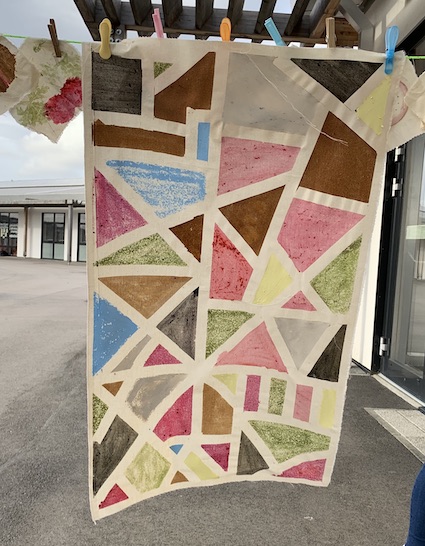
I have been asked on several social media channels about how long such a piece of artwork will last. This depends upon where it is hung – shade is better rather than in sunlight. I didn’t use any binders which help keep the colour. I also washed small pieces of fabric which had been used in the same way. About 50% of them came out clean enough to re-use. Those which aren’t I could re-launder and see if this helps. However they are also good for making char cloth – similar to charcoal but it’s material not wood.
For similar blog posts, have a look at this masking tape shape explorations blog post.
This blog post was originally published in February 2020.






























Wow. Can’t wait to have a go at this. Think of all the nice maths talk and shape language as well: angles, straight lines, long, short
as you decide where to put your marks.
Thank you for another inspirational idea
Thanks Sharon – it is straightforward and enjoyable – but the value of children playing with the taped cloth I think would be great in its own right too.
Juliet somehow you and I became friends on Facebook a while back, I have always enjoyed seeing your posts extolling the joys of the outdoors! I teach kids classes in my studio, we also have summer camps, one of them is a nature camp. We will be recreating this project, keep doing what you’re doing!
Thanks Audrey – delighted to know you are still working with children and supporting outdoor play. I hope your children enjoy this experience.
Very inspired. Next on our group To-Do list!
Thanks Juliet.